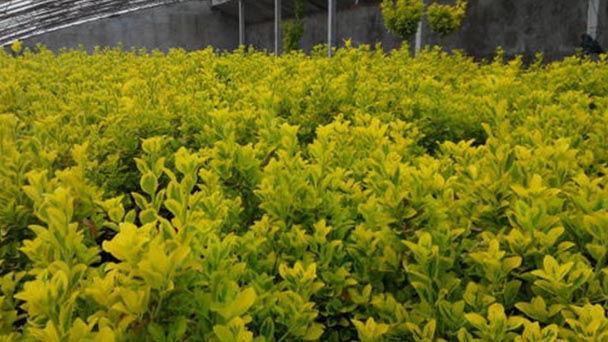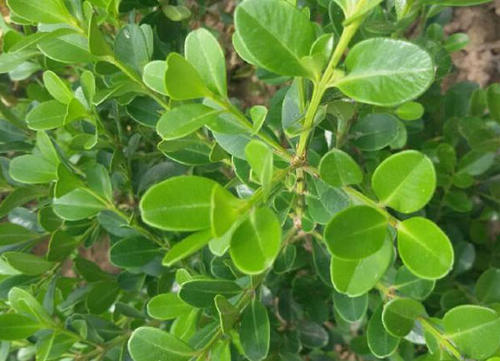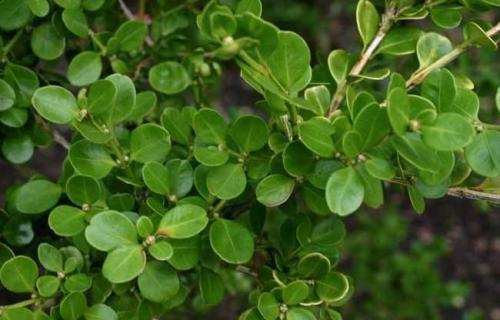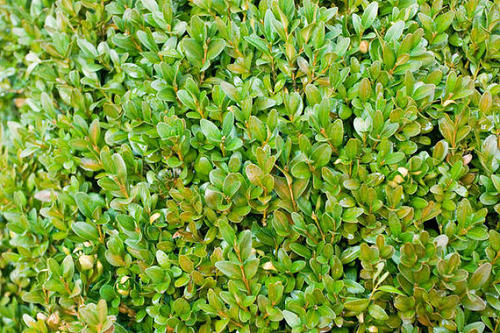Littleleaf box profile
Written by Maggie
Feb 01 2021

Littleleaf Box, scientific name Buxus microphylla, is a shrub or small tree, 1-6 m tall; Branches are cylindrical, longitudinal edges, grayish-white; Branchlets are four-prismatic, comprehensively pubescent or glabrous externally to both sides. Leathery leaves, broadly elliptic, broadly obovate, oval or oblong, bright leaves, protrudent midvein, often fine hairs in the lower half.
Littleleaf Box picture

Morphological characteristics of littleleaf box
Littleleaf Box (Buxus microphylla) is a shrub or small tree, 1-6 m tall; Branches are cylindrical, longitudinal edges, grayish-white; Branchlets are tetragonal, pubescent or glabrous externally to both sides, internodes 0.5-2 cm long. Leaves of Littleleaf box are leathery, broadly elliptic, broadly obovate, elliptic or oblong, oval most 1.5 3.5 cm long, 0.8 2 cm wide, apex rounded or obtuse, often have a small gap, not sharp, base rounded or acute or cuneate, adaxially light, midrib prominent, second half very fine hairs, lateral veins, back midrib flat or slightly convex, often on midrib densely covered with short white linear stalactite, devoid of lateral veins, petiole 1-2 mm, topcoat.
Inflorescences of Littleleaf box (Buxus microphylla) are axillary, capitate, densely flowered, rachis 3-4 mm long, hairy, bracts broadly ovate.2-2.5 mm long, more or less hairy back; Male flowers of Littleleaf box: ca. 10, sessile, outer sepals ovate-elliptic, inner sepals suborbicular, 2.5 -- 3 mm long, glabrous, stamens with anthers 4 mm long, sterile pistils clave-stalked, terminal enlarged, about 2 mm tall (height about 2/3 of sepals length or equal to sepals); Female flowers of Littleleaf box: Sepals 3 mm long, ovary slightly longer than style, glabrous, style coarsely oblate, stigma obcordate, descending to the middle of style.
The capsule of the Littleleaf box is subglobose, 6-8(-10) mm long, persistent style 2-3 mm long.
Littleleaf box origin of habitat
Littleleaf box (Buxus microphylla) is more living valleys, streams, forests, 1200-2600 meters above sea level.Production of China Shaanxi, Gansu, Hubei, Sichuan, Guizhou, Guangxi, Guangdong, Jiangxi, Zhejiang, Anhui, Jiangsu, Shandong provinces, part of the cultivation. The type specimens were collected from Changyang County, Hubei Province.
Littleleaf box growth habit
Littleleaf Box (Buxus microphylla) is fond of loose loam soil, slightly acidic soil, or slightly alkaline soil, and can grow in limestone soil. Potting soil can be ripe garden soil or leaf rot soil mixed with the right amount of rice chaff ash. Littleleaf box is light-tolerant, can maintain good growth in general indoor and outdoor conditions. Long-term shaded environment, although the leaves can remain green, but easy to lead to branches long or weak. Littleleaf box likes wet, can endure continuous about a month of rainy weather, but avoid long water. Littleleaf box is drought resistant, as long as the surface soil or basin soil is not completely dry, without abnormal performance. Littleleaf box is heat resistant and cold, can withstand the summer exposure and temperature of about minus 20 degrees Celsius, but high temperature and humidity in summer should be more ventilation and light. The soil requirements are not strict, with easy and fertile sandy loam is better, pot can also be used with vermiculite, peat or soil, alkali resistance is strong. Littleleaf box has strong tillering, resistant to pruning, easy to shape. In autumn, when the leaves are fully illuminated and dormant, they turn red.
The geographical distribution of littleleaf box
Littleleaf box was produced in Jiangsu, Gansu, Hunan, Hubei, Sichuan, Guizhou, Guangxi, Guangdong, Jiangxi, Zhejiang, Anhui, Shandong provinces, some of which belong to cultivation.
Littleleaf box propagation methods
Sow
In early September, the sandy soil with loose and fertile soil and good drainage was selected as the seeding ground for Littleleaf box. The bottom fertilizer (organic fertilizer) was applied and mixed with carbendazim and other insecticides and fungicides. After deep leveling, the seeding bed was made. The seeding amount is 50-60 grams per square meter. After the seeds of Littleleaf box are mixed with the right amount of sand, they are evenly spread on the seedbed, covered with 1-1.5 mm fine soil, and covered with a layer of grass curtain to keep wet. After sowing, seeds of Littleleaf box only grow radicles and do not germinate. In order to prevent freezing damage, 5-8 cm of soil was covered on the grass curtain before the soil was frozen in winter. In the spring of the same year, the grass curtain and soil will be removed, put plastic arch shed on the seedbed, and the temperature will be controlled at 25-30℃. About 20 silkworm germ long unearthed surface, then the temperature in the shed is controlled between 20-25℃, and appropriate watering, in late spring gabout stable temperature, remove the plastic arch shed. At the seedling stage of Littleleaf box, weeds should be pulled and soil loosened, water should be irrigated in time, and foliar topdressing should be sprayed with 2% potassium dihydrogen phosphate solution repeatedly, and diseases and insect pests should be controlled in time.
Cutting
Seedbed: cutting seedbed of Littleleaf box should choose high terrain, deep soil layer, loose soil, good drainage and irrigation plots. After the removal of grass roots and stones, the whole 1-1.2 meters high bed, with 10% imidacloprid 1000 times plus 5% mancozeb 1500 times pouring, remove underground pests and harmful bacteria. After leveling the seedbed of Littleleaf box, beat it with a spade, and pour 10% of the decayed human excrement on it, and then spread a layer of sifted coke marl or yellow soil on the bed surface. The thickness is about 5 centimeters.
Cutting: Littleleaf box can be propagated by cuttings at any time, but it has a high survival rate in summer when the tender branches grow in the same year are used as cuttings. The cuttings are selected from the excellent branches that are lignified or semi-lignified. After cutting collection, cutting of Littleleaf box should be carried out in a cool and leeward place, and the knife should be sharp. In the latest cut, the festival has a long branches and branchlets truncation each 0.5 cm up and down the section, born again according to the small branches of the position of the stem section is split into two and a half, two hours cutting, not grow on the branches of the branchlets to stay 2 day, 1 cm above the top in the bud cut cost aspect, bottom in the bud cut into 0.5 cm, ear shape or sliced.
Cuttage: cutting of Littleleaf box should be shallow not deep, branchlets cuttage cross section down, depth to the mother plant into the soil 1 cm is appropriate; The depth of large cuttings is the next stem joint inserted in the upper 1 cm, cuttings and ground into about 45 degrees of inclination, shallow insertion oblique insertion is conducive to early rooting cuttings survival. Cuttings of Littleleaf box after the soil around the cuttings compaction and then pouring a permeable, so that the lower part of the cuttings and soil compaction. Cutting row spacing is generally 12-15 cm, plant spacing 6-8 cm. Cuttage, cuttings on the leaves should not be left too much, it is not all cut off, the lower part of the leaves can be all even petiole cut, leave 2 leaves on the upper part, and then according to the size of the leaf, each leaf ran cut on 1/2 to 2/3, reduce excessive consumption of water and nutrients.
Management: after Littleleaf box (Buxus microphylla) cuttings, shade is required to reduce transpiration and direct sunlight to the seedbed. Early spring or late autumn cuttings, should also be covered with film, to prevent winter harm. Cuttage should also be often watered, keep the seedbed soil moist, to seedbed surface soil not white is appropriate. Cutting seedling topdressing of Littleleaf boxcan be combined with watering, can also be used potassium dihydrogen phosphate and urea for foliar spraying.Weed work to be very careful, do not collision cuttings.
Transplant: about a month can be root, 2 months or so transplantation into the nursery cultivation. The first summer and autumn need appropriate shade, after the second year, can be general management. In the Littleleaf box growth period, monthly application of nitrogen water 1- 2 times, after autumn stop fertilization. Cultivate 2-3 years old seedlings, can be planted in small pots;4-5 years old seedlings, only for flower bed edge or ground planting.

Littleleaf box growing methods
Spacing
Littleleaf box (Buxus microphylla) trees do not have strict requirements on soil, sandy soil, loam soil, brown soil can be planted, but the best is rich in organic matter loam soil. Ground preparation requires flat ground type. Combined with deep turning, plus organic fertilizer, about 2000 kilograms per mu. Application of basic fertilizer should pay attention to organic fertilizer must be fully decompose, deep in the planting hole. Littleleaf box planting time in the climate conditions of the Beijing area, planting seedlings in spring, generally in early "Tomb-sweeping Day" before two or three days is appropriate. Littleleaf box tree planting on the open ground general plant row spacing: 0. 5×1. 5 or 0. 4×1. 2 meters, about 1000-1500 plants per acre. With the growth of the tree age, later can be separated from the seedlings.LittleLeaf Box can be planted in holes or trenches.
Before planting Littleleaf box seedlings, make line points according to the planned row spacing, dig holes according to points or ditch according to the planting row spacing, ditch depth should be greater than the seedling root depth, about 40 cm deep. Before planting Littleleaf box, it should be deep application of basic fertilizer, will be fully decayed organic fertilizer and soil mix, applied to the bottom of the hole. When planting Littleleaf box, remove the nutritive bowl from the seedlings, arrange them in the ditch according to the spacing of the plants, so that the roots contact the soil, and fill the soil. After covering the soil, step on the real time. Do not break the soil ball, but step on the gap between the soil ball and the tree hole. The depth of soil cover should be slightly deeper than the original soil mark, so as not to expose the root system after irrigation and affect the survival.
Watering
Watering is the main measure to ensure the survival of Littleleaf box (Buxus microphylla) seedlings, especially in the northern spring drought, less rain, evaporation, if the water supply is insufficient, will seriously affect the survival rate of seedlings. After planting seedlings can be every 4 to 6 rows in the row with soil to build up ridges, for irrigation. Requirement after planting seedlings within 24 hours irrigation water for the first time, every 3 to 5 days irrigation water for the second time, and then every 5 to 7 days irrigation water for the third time, after irrigation sanshui, according to the weather and the situation of seedlings to decide whether irrigation. The water quantity for Littleleaf box should not be too large or too small. If the water quantity is too large, the soil will become soft and the seedlings will be prone to lodging. Too small amount of water affects survival. Planted seedlings of Littleleaf box after irrigation or more rainfall, seedlings easy to lodging, tilt or exposed roots, such as such phenomenon, should be immediately straightened, soil, trampling, otherwise because the seedlings are germinating growth, within a few days the seedlings will be bent dry. When cultivating Littleleaf box seedlings, you can dig up the soil near the roots of seedlings, straighten the seedlings, find the direction between the lines and the strains, and then return the soil steadfast. After planting seedlings after three times of continuous irrigation, when the seedbed soil subsidence and potholes, should be timely leveling, filling. The ground columbine can also be combined with the medium tillage, so that the seedlings receive the same amount of water, to prevent uneven drought and flood. Littleleaf box tree more like water, in the watering should master the "rather wet do not dry" principle. In the Littleleaf box seedling stage, the root system is shallow, sensitive to water, generally to keep the top soil moist as a degree, should be a small number of irrigation. In the period of rapid growth of seedlings, rapid growth, large water demand, should be irrigated with water, so that it is wet and dry, pouring full irrigation.However, in the late growth period, irrigation should be stopped in order to prevent seedlings from growing uneffectively and promote lignification. Generally in the summer should begin to control watering.Irrigation time: each watering time, the best in the morning and evening, not in the highest temperature at noon.
Weeding
Weeding in medium tillage is regular work in Littleleaf box (Buxus microphylla) seedling management. Medium tillage and weeding are two concepts, but can be done in combination. General tillage weeding had better be carried out after rain or irrigation, the grass will be uprooted when the soil is wet, loose soil effect is good. Seedling newly planted soon, most of the soil surface exposed to the air, not only the soil is easy to dry, but also prone to weeds, during this period should be timely plowing weeding, in order to facilitate the development of seedlings root system. General seedling roots near should be slightly shallow tillage, plant row can be appropriate to deepen, usually 3 to 5 cm. Ploughing during the rainy season can prevent waterlogging by promoting gas exchange and evaporation of gaseous water. In northern China, spring is usually dry, and weeds have stopped growing in autumn. In these two periods, intertillage should be the main method, and weeding should be the main method in summer. The rapid growth of weeds is around the rainy season, this period to strengthen weeding, weeding to adhere to the early, small, in addition to the principle. Perennial weeds must be dug out of their underground parts, otherwise, it will become more and more difficult to remove.
Plastic
At any time during the growth period to cut long branches, overlapping branches and affect the shape of the tree redundant branches. LittleLeaf box sprouts quickly. Generally, 1-2 sections of the apex are cut off after the shoots are sprouted to prevent the growth.Littleleaf box results, to timely pick, so as not to consume nutrients, affect the growth of the tree.
Double basin
General 2-3 years for a time before the spring germination as well. Combined with turning over the basin to cut off part of the old roots and too long too dense root system, replace 1/2 old soil, plug with fertile loose culture soil, to facilitate the development of root system.
Littleleaf box disease and pest control
LittleLeaf Box (Buxus microphylla) is mainly infested with scale insects and LittleLeaf Box ulnar crab. Scale insects can be killed by manual scour or sprayed with 80% Dichvos 1500 times liquid. LittleLeaf box is sprayed with 80% trichlorfon sniper powder or 40% diethoate oxide 1000-2000 times. The main disease is coal pollution disease, will cause the phenomenon of deciduous, the key to prevent and control is to remove scale insects, and often spray foliar water, wash dust, so that it grows well.

The main value of littleleaf box
Bonsai
Littleleaf Box (Buxus microphylla) Bonsai tree graceful, leaves as small as bean, thick and shiny quality, evergreen, can be viewed all year round. Yang school Littleleaf box bonsai, branches and leaves after cutting processing, into "cloud sheet", flat thin as cutting, and then dotted with rocks, beautiful picturesque. Littleleaf Box is very pleasing to the eye with its spring foliage. Ancient chant Littleleaf box poem, hurricanes Littleleaf box tree, old to branch thousand heavy, leaf deep garden jade.
The botanical garden
Littleleaf Box (Buxus microphylla) luxuriant foliage, green lovely, generally used as hedge trees and trim into a ball, can also be planted in the open forest, under the forest or forest edge layout, is also often with red leaves of the safflower trees, golden leaves of the privet and other shrubs composition color block
Wood carving
Littleleaf box (Buxus microphylla) wood carving is a kind of round carving art, based on Littleleaf box wood, originated in Yueqing, has a history of more than 160 years. Along with Dongyang wood carving and Qingtian stone carving, it is known as the "Three Carvings in East Zhejiang". It uses the Littleleaf Box wood of the natural form of smooth wood, fine texture and solemn color. Littleleaf Box wood (Buxus microphylla) carving is creamy-yellow, the longer the time, its color from light to deep, give a person simple and elegant beauty.
Latest Updated
- Benefits of Bugleweed - 7 Science-backed Health Benefits
- Bugleweed Dangers & Side Effects - Is It Poisonous?
- How to Plant Evergreen Trees - What You Should Know
- When to Plant Evergreens - Grow Guide for Evergreen Trees
- 12 Wonderful Evergreen Shrubs for Your Garden
- 12 Popular Evergreen Plants with Pictures for Beginners
- When And How To Prune A Lilac Bush Like a Pro
- How to Grow & Care for Lilac Vine (Hardenbergia Violacea)
- Japanese Lilac Tree (Syringa Reticulata) Care & Propagation Guide
- Shumard Oak Pros and Cons - What to Know
Popular Articles
- Winter maintenance of Antirrhinum Majus
- How to Grow Terminalia Mantaly Tree
- How to Grow and Care for Crossostephium Chinense
- How to grow Antirrhinum Majus in spring
- Peristeria Elata (Dove Orchid) Profile: Info & Care Guide
- Underwatered Snake Plant (Sansevieria Trifasciata) - Signs And How To Fix
- How to Care for Brazilian Jasmine Plant (Mandevilla Sanderi)
- How to Grow & Care for Graptopetalum Purple Delight in Summer
- Rosa Chinensis (China Rose): Plant Growing & Care Tips
- How to Care for Baby Sun Rose (Aptenia Cordifolia)